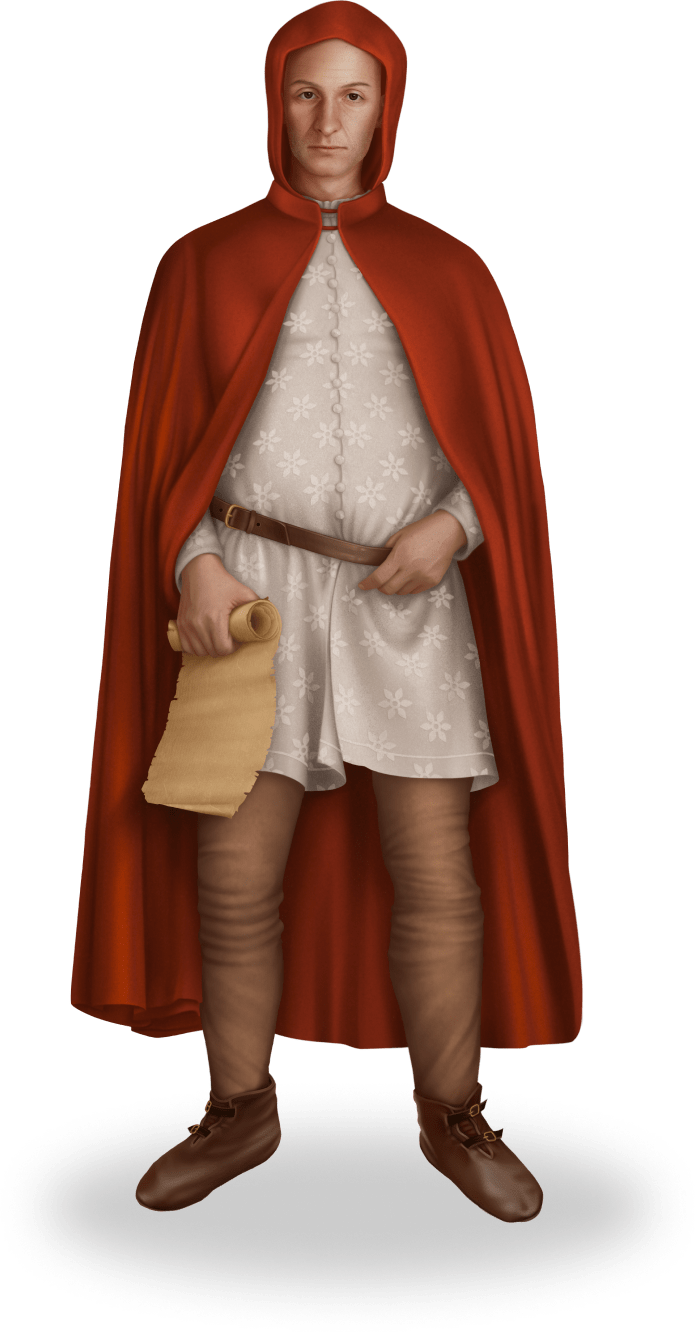Prior to Giovanni Bocaccio, literary culture in fourteenth century Italy was dominated by two other titans: Dante Alighieri and Petrarch. Although both are famous as writers, to label them as such is to misrepresent the enormous impact of their works – not just in Italy but across Europe. Together, the two helped shape the course of European culture.
Born in Florence in around 1265, Dante is widely recognised as the author of the most important work of literature in the Italian language, The Divine Comedy. Divided into three parts, this epic poem tells the story of a man (often identified as Dante himself), as he journeys into Hell (Inferno), then to Purgatory, and finally to Paradise (i.e. Heaven), accompanied by the ancient Roman poet, Virgil, and later by the love of his life, Beatrice Portinari. His other most famous work, La Vita Nuova, celebrates his love for Beatrice, whom he met as a young boy but never married.
Perhaps the most important of Dante’s decisions was to write The Divine Comedy in Tuscan (the precursor to modern Italian). By using the vernacular language, as opposed to Latin, Dante contributed significantly to the creation of an Italian language, and it also made his work significantly more accessible. Later writers, including both Petrarch and Boccaccio, would follow his example.
Although he loved his native Florence, Dante ended his life as a political exile. Caught between the interests of the two political parties in the Republic, the Guelphs and the Ghibellines. As a member of the Guelphs, Dante recognised the authority of the pope as head of the Catholic Church, but not of secular affairs. Charged by his opponents from a faction within his own party, he was exiled in 1302. He lived out the remainder of his days in various cities across northern Italy, dying in Ravenna on 13th September 1321. Although Florence had repeatedly tried to get him to return, he refused. His importance was quickly recognised over the course of the fourteenth century, and he was recognised as the divino poeta (the "divine poet"). Giovanni Boccaccio even wrote a life of the poet and delivered lectures on the The Divine Comedy in 1373!
"There is no greater sorrow than to recall in misery the time when we were happy" – Dante Alighieri, Inferno.
Francesco Petrarca, otherwise more commonly known as Petrarch, was born on 20th July 1304 in Arezzo in Tuscany. As well as a poet, he is renowned especially as a scholar and a humanist. He is a key figure in the emergence in fourteenth and fifteenth century Italy of the Renaissance and the revived interest in the arts and ideals of Classical antiquity that followed.
Abandoning his legal studies, he followed his true passions for literature. Moving to Avignon, the temporary home of the papacy in the fourteenth century, Petrarch would meet Laura. She would become the idealised subject of his celebrated lyric poetry, many of which are presented in his Canzoniere (1360).
Petrarch travelled widely, and especially sought out manuscripts of Classical authors. Some of his most famous discoveries included speeches of Cicero, discovered in the Belgian city of Liege. He argued strongly for a continuity between Classical culture and the Christian message (a belief enhanced by his study of St Augustine’s Confessions). Later in his life, he would work on a text – in Latin – called de viris illustribus. It aimed to present biographies of the great men of Roman history but was expanded to included famous men from all of history, beginning with Adam. His appreciation of, and engagement with, the Classical past as a source of inspiration and philosophical meaning would be hugely important in Renaissance culture in the centuries that followed.
"I observe about me dying throngs of both young and old, and nowhere is there a refuge. No haven beckons in any part of the globe, nor can any hope of longed for salvation be seen. Wherever I turn my frightened eyes, their gaze is troubled by continual funerals: the churches groan encumbered with biers, and, without last respects, the corpses of the noble and the commoner lie in confusion alongside each other." Petrarch, Ad seipsum ("To Himself"), ca. 1348 describes the horrors of the Black Death.






